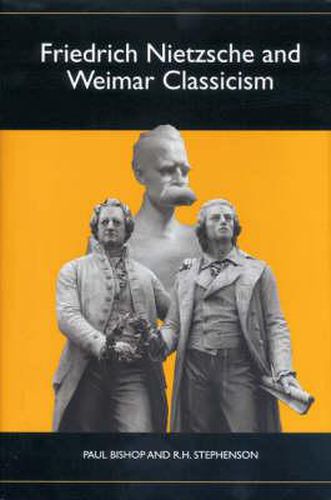Readings Newsletter
Become a Readings Member to make your shopping experience even easier.
Sign in or sign up for free!
You’re not far away from qualifying for FREE standard shipping within Australia
You’ve qualified for FREE standard shipping within Australia
The cart is loading…






This book argues that Nietzsche’s polemics against the 19th-century reception of Goethe and Schiller should not obscure his own more positive evaluation of Weimar classicism, as has generally been the case. The authors uncover the continuing influence of Weimar classicism at the very heart of Nietzsche’s aesthetic theory, which in turn became the cornerstone of his epistemological and moral concerns. The book takes as its starting point the view that Thus Spoke Zarathustra has a single, coherent message that it identifies with what Goethe called the gospel of beauty. A hitherto unappreciated unity of plot, style, and argument is thus revealed in both Zarathustra and Nietzsche’s philosophical oeuvre as a whole, showing how he participates in a perennial aesthetic. In this connection Nietzsche’s statement in The Gay Science is revealing: I want to learn more and more to see what is necessary in things as what is beautiful ? then I shall be one of those who make things beautiful.
The book provides an overview of related scholarly literature; discusses Nietzsche’s aesthetic theory in The Birth of Tragedy; recounts the composition of Thus Spoke Zarathustra and offers an interpretation of its aesthetic gospel ; a concluding chapter explores historical continuities in aesthetic theory. By demonstrating the constitutive function of the aesthetics of Weimar classicism in his philosophy, this book opens up a fresh and original perspective on Nietzsche. Paul Bishop is Professor of German, and R. H. Stephenson is William Jacks Professor of German Language and Literature, both at the University of Glasgow.
$9.00 standard shipping within Australia
FREE standard shipping within Australia for orders over $100.00
Express & International shipping calculated at checkout
This book argues that Nietzsche’s polemics against the 19th-century reception of Goethe and Schiller should not obscure his own more positive evaluation of Weimar classicism, as has generally been the case. The authors uncover the continuing influence of Weimar classicism at the very heart of Nietzsche’s aesthetic theory, which in turn became the cornerstone of his epistemological and moral concerns. The book takes as its starting point the view that Thus Spoke Zarathustra has a single, coherent message that it identifies with what Goethe called the gospel of beauty. A hitherto unappreciated unity of plot, style, and argument is thus revealed in both Zarathustra and Nietzsche’s philosophical oeuvre as a whole, showing how he participates in a perennial aesthetic. In this connection Nietzsche’s statement in The Gay Science is revealing: I want to learn more and more to see what is necessary in things as what is beautiful ? then I shall be one of those who make things beautiful.
The book provides an overview of related scholarly literature; discusses Nietzsche’s aesthetic theory in The Birth of Tragedy; recounts the composition of Thus Spoke Zarathustra and offers an interpretation of its aesthetic gospel ; a concluding chapter explores historical continuities in aesthetic theory. By demonstrating the constitutive function of the aesthetics of Weimar classicism in his philosophy, this book opens up a fresh and original perspective on Nietzsche. Paul Bishop is Professor of German, and R. H. Stephenson is William Jacks Professor of German Language and Literature, both at the University of Glasgow.